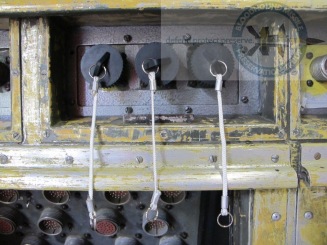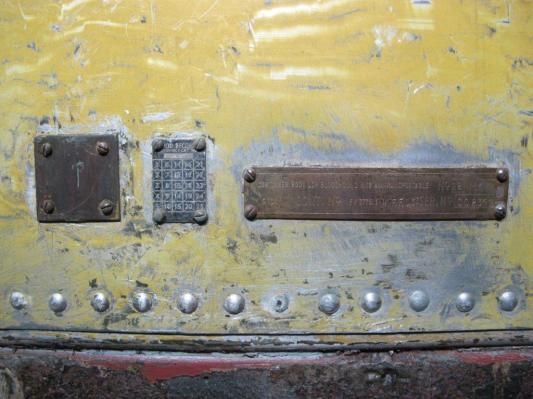So we battle on …. We are still seeking voluntary assistance to help complete the LCP and work on the T86 radar which are located in a secure, restricted access, storage facility on the outskirts of Telford. Team members meet up most Saturday’s but come along when you have time; you do not have to come every Saturday. If interested email contact@bmpg.co.uk. Unfortunately we do not receive funding so cannot cover travel or other expenses.
Month: July 2016
41 Sqn Badge Found
When scraping paint from the LCP door today we uncovered some homemade artwork of a 41 Sqn badge as below. So our LCP, Ser. No. 1022, was either on 41 Sqn MS4 or MS6. Are there any old 41 Sqn guys around that possible remember if 41 painted their squadron badge on all their LCP’s or just 1022. Perhaps we can actually narrow 1022 down to MS4 or MS6. 1022 was definitely at Wildenrath as one of our team worked on it there.
This is what it should have originally looked like.

Current Status With Aerospace Bristol
The shared vision between ourselves and the exhibition development team at the new Filton museum was for our LCP and T86 radar to be displayed alongside the definitive national tandard Mk2 Bloodhound missile. However, over the last three years there have been significant organisational changes at what was called the Bristol Aerospace Centre and is now known simply as Aerospace Bristol run by the Bristol Aero Collection Trust. Their emphasis is markedly on Concorde of which there are a number on display elsewhere but now with with scant regard for this unique Bloodhound project.
Aerospace Bristol is due to open in the summer of 2017 with the missile on its own in the exhibition. However, it is still our plan for the LCP and T86 radar to be transferred to Filton but they will not on display at the time of opening. They will remain fully under the control of the owners BMPG Ltd (us) with the enduring vision that this important Cold War defence missile system will be displayed as an entity with the public access it requires.
Work Day July 30

With Neil, Pete M, Ian and myself (Pete H) on site a good amount of work was carried out. Plenty of the usual paint scraping which led to some excitement when it uncovered a 41 Sqn badge that had been painted on the LCP door. Obviously it confirms that our LCP, Ser. No. 1022, was on a 41 Sqn section before going to Wildenrath with 25 Sqn. Richard Vernon applied his knowledge and some good detective work and we believe that LCP 1022 was (possibly) on 41 Sqn MS6 in the late 1960’s.
One task being picked up again was the refurbishing of the covers for the cable outlets on the LCP cabin. All the rubber seals need replacing for a start! We are paying attention to detail as such items as the small, circular, chrome covers for the securing catches are being replaced as several have had their covering flaps broken off over the years. We also looked at removing the glass from the window in the E.C.’s door as the seal could do with renewing. A task we’ll only carry out if there is zero risk of damage or breaking the glass. Paint removal from the cabin has also revealed a good number of dents that have been filled before a repaint – at some time in the past. A good number of these dents appeared to be in a line so speculation ensued. Was this LCP air transported at some time and the air movements people were not that careful?
The final task was to run up the LCP and check the simulator was still serviceable, it is. The FT81 monitor had a bit of a wobble with the vertical sync taking a while to settle down. not a problem for us as if it needs removing and possibly repairing as we have a spare in the LCP.
Work Day July 23
The main work of the day was yet more paint scraping on the LCP but the end wall is now finished (see below), just the front and the roof to go. The end wall took a fair bit of time due to the cable ducts and the sheer number of rivet heads.

In a gap with the scraping I created a few lanyards for the plug and socket covers.

Looking good if I say so myself but I did say to Neil today that I couldn’t find a replacement swivel, Neil emailed me to say he has ordered enough swivels (they stop the lanyard from twisting) which are as near as he could get to the original, see photo.

Now; can anyone find boot lace ferrules as per photo that will crimp 3mm cord? The attached photo of the original lanyard is the only example I have of an original lanyard, a couple of others I have are are very badly corroded and most of the plug covers were just tied on to the split ring with no crimps.

We finished the day with a short discussion on if and how we could get a replacement seal for the window in the E.C.’s door. Perhaps the same type of seal used in 1960’s car windscreens? Wafting heat guns around the window and its seal is not a good idea. Can anyone help on this one and possibly find a source?
Work Day July 16
The sim was run up after a break of two weeks and pleased to say it remains serviceable.
The LCP cabin restoration continues! Quite a gang of us today as besides Neil and myself (Pete H) there was Richard V plus Dave S and his brother-in-law John. Neil and Richard had an inspiring day scraping paint of the end wall of the LCP cabin; a definite ‘mind in neutral’ job. Dave and John spent a fair bit of time battling to remove the awning spreaders from the LCP roof. After doing battle with rusted bolts and their castellated nuts retained with rusted split pins it was decided that the complete bracket assembly for each spreader would be unbolted from the cabin roof to make life easier for all. The spreaders can then be restored at a later date while the main effort remains on the main cabin. I spent time on corrosion treatment of screw heads and priming the cable duct housings of the left hand wall of the cabin. The housings are fibreglass so a special ‘plastic’ primer is being used – only available in black!
Work day July 16
The sim was run up after a break of two weeks and pleased to say it remains serviceable.
The LCP cabin restoration continues! Quite a gang of us today as besides Neil and myself there was Richard V plus Dave S and his brother-in-law John. Neil and Richard had an inspiring day scraping paint of the end wall of the LCP cabin; a definite ‘mind in neutral’ job. Dave and John spent a fair bit of time battling to remove the awning spreaders from the LCP roof. After doing battle with rusted bolts and their castellated nuts retained with rusted split pins it was decided that the complete bracket assembly for each spreader would be unbolted from the cabin roof to make life easier for all. The spreaders can then be restored at a later date while the main effort remains on the main cabin. I spent time on corrosion treatment of screw heads and priming the cable duct housings of the left hand wall of the cabin. The housings are fibreglass so a special ‘plastic’ primer is being used – only available in black!
Info
I (Pete H.) have amassed the bits to create plug and socket lanyards including a crimp tool. Below is the end result of crimping but I need to check that the split rings fitting on the plugs. The rings I have are the nearest size to the originals I could get, plus Dave has liberated original split rings from Newton which we’ll use. Also, there is nylon cord at the hangar courtesy of Neil. The original cord was cotton but the replacement nylon but I reckon that’s fine.

I was in the local hardware store today and dug up some green, yellow and black enamel paint. Old stock and no one knew how much a tin was! We need this paint to surround the firing line plugs as per here:

Work Day July 9
Another fantastically boring but therapeutic (according to Neil) day as we continued with the master plan of getting the LCP repainted before the end of summer. The rear wall of the cabin is now completely stripped and ready for a gentle rub down before painting, thanks to Neil’s efforts this morning. The majority of the day was spent on the side wall of the cabin as shown in the before and after photos attached. Hard work, especially cleaning all the rivet heads and roof catches. Another full day should see this side wall finished. The hot air guns are still working at maximum efficiency as Neil can testify after burning his hand so next time you are with us please ask to see his scars.

A couple of photos of the T86 attached to prove it’s still there.


Work Day July 2
Today: Neil’s arms nearly dropped off, or they felt they were about to as he finished paint scraping the rear wall of the cabin.

See the attached photos for the ‘uncovered’ ID labels on the side of the LCP, long since painted over but now exposed to daylight once more.


I started some painting – at last! The cable ducts on the cabin behind ‘M’ rack have plugs and sockets that are part of M Rack units and as such the mounting plate is painted in Hammerite ‘hammered’ grey, at least they were originally. Grey hammered Hammerite is no longer available. I sourced a tin of obviously old stock from eBay. You will also see from one of the photos the black painted surrounds of four cable ducts. The black paint is plastic primer as the housing here is glass fibre. Apart from the items currently in Hammerite the rest will be NATO Green. As I had the grey Hammerite open I also did a bit of touching up in the LCP to hide scratches and chips in paintwork. Note the old and new photo of the securing latches used on covers – good old eBay again. I purchased a couple of sets of these latches this week.

Off-site I continue to do battle with trying to fault find GL Processors. The ME153 is a closed loop in that it the master clock pulse is stopped whenever there is a problem on the unit. I’m looking at how I can inject a clock pulse, if it’s possible.








